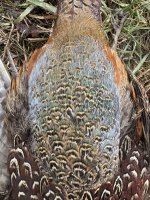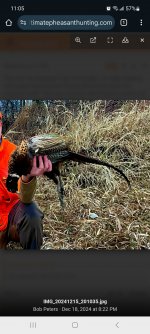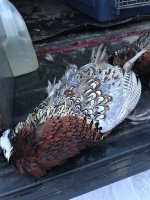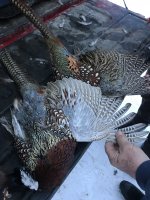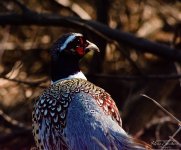You are using an out of date browser. It may not display this or other websites correctly.
You should upgrade or use an alternative browser.
You should upgrade or use an alternative browser.
Help on a special kind of wild pheasant.
- Thread starter Bob Peters
- Start date
Limitless
Well-known member
This is interesting. I got one rooster in SW MN today. When I looked at him, I thought the upper back feathers were darker brown than usual, as well as the chest. He also had some green flecks on the sides of the chest feathers. Sure enough, when I got home, I compared him to my 3 birds from the prior day, still intact, and he is different. He isn't a black melly like you would see at a game farm, but he has some similarities to Joe Hunter's bird above.
20 minutes or so before I got him, a rooster flushed wild. I thought he looked extra dark. It could have just been the lighting, or something in the local gene pool, or he ended up being the one we got. He was a smart boy, and an unbelievable scrapper.
I clocked him quite a ways away on my 3rd shot, and could tell he was winged. It was relatively short wetland grasses and 3-4 inches of fresh snow where he fell. We hustled up there and Honey wanted to keep going. She found him another 60-70 yards up from where I would guess he fell (133 yards total), but after one mouth full of feathers, he flipped, and vanished before our eyes. We both looked all over for over 10 minutes. I stepped down all the snow and grasses by the pile of feathers and 5 to 10 feet in every direction. I did think if he had burrowed in, his scent might finally reach the surface if we waited long enough. The only other option was if he scooted under the snow and out of that area, but I just didn't think he had.
Finally, 3-4 feet from where he was last seen, and where I had stepped down the snow, and where Honey had been a number of times, Honey sniffed him out. He must have been right on the ground and didn't budge with me stepping on him.
Another rodeo ensued, but Honey hog tied him this time. She wasn't messing around. Normally when I grab a bird from her, that's it. But both were still fighting with each other as I held him.
I wrung his neck, and since he was kicking me, I dropped him. After a while, I started to wonder if I had done it completely. Head looked dead, but body was still moving. I picked him up again, and did it in another spot. Dropped him again, and his dead body kicked the ground hard enough to make him pop off the ground.
One smart, tough, mutant, bird.
Oh, and related to another thread, the end of his spurs were worn down to white too. An all in one bird.
Will post comparison photos tomorrow or the next day. Have to get up early again to try to thin out the gene pool.
20 minutes or so before I got him, a rooster flushed wild. I thought he looked extra dark. It could have just been the lighting, or something in the local gene pool, or he ended up being the one we got. He was a smart boy, and an unbelievable scrapper.
I clocked him quite a ways away on my 3rd shot, and could tell he was winged. It was relatively short wetland grasses and 3-4 inches of fresh snow where he fell. We hustled up there and Honey wanted to keep going. She found him another 60-70 yards up from where I would guess he fell (133 yards total), but after one mouth full of feathers, he flipped, and vanished before our eyes. We both looked all over for over 10 minutes. I stepped down all the snow and grasses by the pile of feathers and 5 to 10 feet in every direction. I did think if he had burrowed in, his scent might finally reach the surface if we waited long enough. The only other option was if he scooted under the snow and out of that area, but I just didn't think he had.
Finally, 3-4 feet from where he was last seen, and where I had stepped down the snow, and where Honey had been a number of times, Honey sniffed him out. He must have been right on the ground and didn't budge with me stepping on him.
Another rodeo ensued, but Honey hog tied him this time. She wasn't messing around. Normally when I grab a bird from her, that's it. But both were still fighting with each other as I held him.
I wrung his neck, and since he was kicking me, I dropped him. After a while, I started to wonder if I had done it completely. Head looked dead, but body was still moving. I picked him up again, and did it in another spot. Dropped him again, and his dead body kicked the ground hard enough to make him pop off the ground.
One smart, tough, mutant, bird.
Oh, and related to another thread, the end of his spurs were worn down to white too. An all in one bird.
Will post comparison photos tomorrow or the next day. Have to get up early again to try to thin out the gene pool.
Last edited:
Bob Peters
Well-known member
Once in Iowa hunting around Swea City (funny name) a smart one flushed just out of range. He wasn't jet black, but he was the darkest looking wild pheasant I've ever seen. Really neat colors, wish he would've waited another 30 seconds to flush. 4 years ago in Leola, my buddies both shot at a bird that had a lot more white on him than normal. Kind of cream colored head and shoulders. We were a couple hundred yards away and they signaled us to walk over and help look, but we never could find him. On black friday at Cariboo, Randy gets a bunch of black pheasants in. I've always wanted to do it, but I won't go to the game farm when I can chase wild ones, unless a buddy really twists my arm and puts me in a headlock.
KEOutdoors
Well-known member
You know what, my buddy probably put some filter on that with his Chinese phone. Damn.
Attachments
KEOutdoors
Well-known member
The pheasants forever groups or boyscouts sometimes do youth hunts for youth season and they buy and plant birds on the public lands, often mix in a few black ones for that special touchOnce in Iowa hunting around Swea City (funny name) a smart one flushed just out of range. He wasn't jet black, but he was the darkest looking wild pheasant I've ever seen. Really neat colors, wish he would've waited another 30 seconds to flush. 4 years ago in Leola, my buddies both shot at a bird that had a lot more white on him than normal. Kind of cream colored head and shoulders. We were a couple hundred yards away and they signaled us to walk over and help look, but we never could find him. On black friday at Cariboo, Randy gets a bunch of black pheasants in. I've always wanted to do it, but I won't go to the game farm when I can chase wild ones, unless a buddy really twists my arm and puts me in a headlock.
Bob Peters
Well-known member
I don't think that's enough blue to qualify. Probably a 2nd cousin twice removed.
Bob Peters
Well-known member
I think this is the closest I've come to a Kansas bird. I've deduced that he probably migrated up from Wichita when the wheat stubble went bad and wanted to get some of that delicious Iowa corn. I realize biologists have mentioned a pheasant has a small home range and doesn't migrate. That said, it'd be nothing for a blue back to fly a few hundred miles. He flushed like a rocket from the horsetail with Skye hot on his trail, fastest bird I've ever seen. To this day I still can't believe my move mount and shoot was quick enough to make the shot, I shoulda bought a lottery ticket that day. I'm thinking he was a quarter strain bird, but surely not a blue blood blue back.
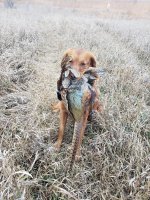

A5 Sweet 16
Well-known member
KBB????
Sorry. Try again soon. That's your garden variety pheasant. The KBB is exceedingly rare. Well, unless you're in Kansas.
Limitless
Well-known member
After a careful necropsy, I am more inclined to believe my bird was just a darker local variation than the product of some more extreme mutation. Here he is next to the 3 birds from the previous day. He is darker than the two next to him, but only a little darker than the one on the other end. The bird on question is on the left in the photo. Shadow over the bird on the right makes him look darker than he was. Also a little wet.This is interesting. I got one rooster in SW MN today. When I looked at him, I thought the upper back feathers were darker brown than usual, as well as the chest. He also had some green flecks on the sides of the chest feathers. Sure enough, when I got home, I compared him to my 3 birds from the prior day, still intact, and he is different. He isn't a black melly like you would see at a game farm, but he has some similarities to Joe Hunter's bird above.
20 minutes or so before I got him, a rooster flushed wild. I thought he looked extra dark. It could have just been the lighting, or something in the local gene pool, or he ended up being the one we got. He was a smart boy, and an unbelievable scrapper.
I clocked him quite a ways away on my 3rd shot, and could tell he was winged. It was relatively short wetland grasses and 3-4 inches of fresh snow where he fell. We hustled up there and Honey wanted to keep going. She found him another 60-70 yards up from where I would guess he fell (133 yards total), but after one mouth full of feathers, he flipped, and vanished before our eyes. We both looked all over for over 10 minutes. I stepped down all the snow and grasses by the pile of feathers and 5 to 10 feet in every direction. I did think if he had burrowed in, his scent might finally reach the surface if we waited long enough. The only other option was if he scooted under the snow and out of that area, but I just didn't think he had.
Finally, 3-4 feet from where he was last seen, and where I had stepped down the snow, and where Honey had been a number of times, Honey sniffed him out. He must have been right on the ground and didn't budge with me stepping on him.
Another rodeo ensued, but Honey hog tied him this time. She wasn't messing around. Normally when I grab a bird from her, that's it. But both were still fighting with each other as I held him.
I wrung his neck, and since he was kicking me, I dropped him. After a while, I started to wonder if I had done it completely. Head looked dead, but body was still moving. I picked him up again, and did it in another spot. Dropped him again, and his dead body kicked the ground hard enough to make him pop off the ground.
One smart, tough, mutant, bird.
Oh, and related to another thread, the end of his spurs were worn down to white too. An all in one bird.
Will post comparison photos tomorrow or the next day. Have to get up early again to try to thin out the gene pool.
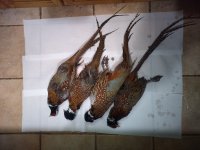
Bird in question is on the right in this next photo.
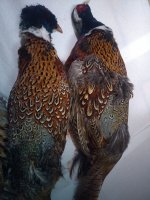
Chest side (he is at the top):
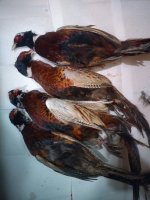
Close up, overexposed:
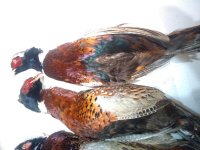
Here are the spurs, which were nothing to write home about, but worn at the tips a bit:
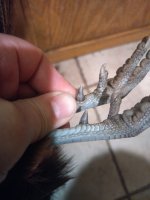
He did prove to have my longest tail feathers of the season, at just a hen's tooth away from 24".
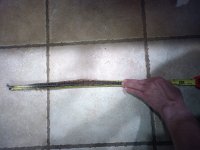

KEOutdoors
Well-known member
remy3424
Well-known member
My granddaughters will always come out to see the pheasants, if they are visiting when I return from my hunts. I show them all those different beautiful feathers and remind the oldest one she can come with me when she is 10. She is pretty "girly", I think I might have a better chance with the 4 year old....or maybe the 2 year old, she is a pistol already.
Goosemaster
Well-known member
I have a 10 year old nephew that went out one day this year.Shot the 28 3 times.His dad hasn't hunted in 39 years!!My granddaughters will always come out to see the pheasants, if they are visiting when I return from my hunts. I show them all those different beautiful feathers and remind the oldest one she can come with me when she is 10. She is pretty "girly", I think I might have a better chance with the 4 year old....or maybe the 2 year old, she is a pistol already.

